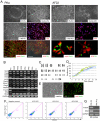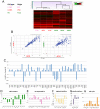Capture of neuroepithelial-like stem cells from pluripotent stem cells provides a versatile system for in vitro production of human neurons
- PMID: 22272239
- PMCID: PMC3260177
- DOI: 10.1371/journal.pone.0029597
Capture of neuroepithelial-like stem cells from pluripotent stem cells provides a versatile system for in vitro production of human neurons
Abstract
Human embryonic stem cells (hESC) and induced pluripotent stem cells (iPSC) provide new prospects for studying human neurodevelopment and modeling neurological disease. In particular, iPSC-derived neural cells permit a direct comparison of disease-relevant molecular pathways in neurons and glia derived from patients and healthy individuals. A prerequisite for such comparative studies are robust protocols that efficiently yield standardized populations of neural cell types. Here we show that long-term self-renewing neuroepithelial-like stem cells (lt-NES cells) derived from 3 hESC and 6 iPSC lines in two independent laboratories exhibit consistent characteristics including i) continuous expandability in the presence of FGF2 and EGF; ii) stable neuronal and glial differentiation competence; iii) characteristic transcription factor profile; iv) hindbrain specification amenable to regional patterning; v) capacity to generate functionally mature human neurons. We further show that lt-NES cells are developmentally distinct from fetal tissue-derived radial glia-like stem cells. We propose that lt-NES cells provide an interesting tool for studying human neurodevelopment and may serve as a standard system to facilitate comparative analyses of hESC and hiPSC-derived neural cells from control and diseased genetic backgrounds.
Conflict of interest statement
Figures






References
-
- Takahashi K, Tanabe K, Ohnuki M, Narita M, Ichisaka T, et al. Induction of pluripotent stem cells from adult human fibroblasts by defined factors. Cell. 2007;131:861–872. - PubMed
-
- Takahashi K, Yamanaka S. Induction of pluripotent stem cells from mouse embryonic and adult fibroblast cultures by defined factors. Cell. 2006;126:663–676. - PubMed
-
- Koch P, Kokaia Z, Lindvall O, Brüstle O. Emerging concepts in neural stem cell research: autologous repair and cell-based disease modelling. Lancet Neurol. 2009;8:819–829. - PubMed
-
- Mattis VB, Svendsen CN. Induced pluripotent stem cells: a new revolution for clinical neurology? Lancet Neurol. 2011;10:383–394. - PubMed
Publication types
MeSH terms
Substances
Grants and funding
LinkOut - more resources
Full Text Sources
Other Literature Sources
Research Materials

